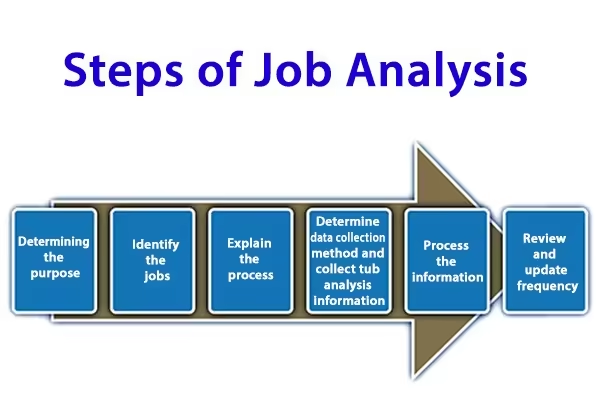Where should employees be placed to make the most of their abilities and talents? How can you figure out if your company needs new employees? How can you get rid of positions that aren't needed? How can realistic performance measuring standards be established? How do you identify job openings and make a plan to fill them? A proper and detailed job analysis, on the other hand, can efficiently accomplish all of this.
Managers face the same issues in the day-to-day operations of their companies, where they must successfully and efficiently meet the organizations criteria for human resource recruitment, selection, performance, and satisfaction, as well as reduce and add extra tasks and duties (Juneja, 2021). And there is no way for them to avoid the possibility of being wrong. For them, an efficient and correct procedure of analyzing a specific project is a huge relief. It enables them to keep high-quality staff, measure their performance against realistic benchmarks, analyze their training and development needs, and boost productivity (Juneja, 2021). Lets take a look at the job analysis process and see how it works.
What is Job Analysis?
Job analysis is the rigorous process of acquiring information about a jobs needed duties and the human traits required to perform those duties correctly. The work products of job analysis are job descriptions, which explain the job, and position specifications, which specify the type of person to hire for the job. Job analysis is the process of gathering data about many aspects of a job. It collects and analyses data about job descriptions and specifications. Job analysis could be considered the foundation of human resource management because it serves as the foundation for many HR programming duties. Job analysis is used for:
- Recruitment - Provides details about the jobs nature to help with recruitment.
- Selection - Provides information on the knowledge, skills, and abilities needed by those who can do the job well.
- Training - Provides information on the tasks to be completed and the skills and expertise needed to assist the construction of training programs.
- Performance evaluation - Provides data on the level of proficiency required for various tasks to set performance criteria.
- Compensation - Provides the data needed to assess the jobs internal value and compare it to positions in the relevant labor market to determine acceptable compensation and benefit levels.
- EEO Compliance - Establishes the foundation for deciding whether or not employment practices and choices are relevant to the job.
If, for now, you are at the stage where homework assignments are more pressing than job analysis, or you need extra time on your hands, delegate academic papers to a essay writing service with professional academic writers. Experts that are working here help graduate and undergraduate students for years, turning writing challenges into viable solutions. Don't be afraid of deadlines and extensive writing load — delegate your tasks and free time for better job analysis.
The Job Analysis Steps

1. Determine the purpose of conducting job analysis
The purpose should be connected to the organizations success and strategic goal. The fact that jobs are significantly more dynamic than they have ever been is a common justification for performing employment analysis initiatives. The nature of the job is frequently changed by technology and the needs of a competitive environment, necessitating reevaluation. Rapid organizational expansion often necessitates the creation of new types of positions, which require the creation of job descriptions. Other indicators of the necessity for job analysis initiatives could include high turnover or low work satisfaction.
High turnover could imply that positions are underpriced in comparison to the external job market. Because pay decisions are based on job analysis, prior job analysis results may need to be changed (Pearson, 2005). Boring or monotonous work is frequently the cause of low job satisfaction. Job analysis can help you develop new methods to design tasks that are more engaging and demanding.
2. Identify the jobs to be analyzed
After the purpose has been determined, it can be determined which jobs should be included in the job analysis. Time and resource constraints, on the other hand, frequently limit the overall number of jobs that can be included in the process. For example, if the company has a high turnover, the data should be reviewed to determine which divisions are suffering the most problems. The projects direction is determined by this analysis. The same is true if the company is expanding or changing dramatically in only a few places. These are the kind of jobs that are best suited for job analysis.
When a significant number of people are assigned to the same job, it is necessary to decide how many will be included in the project. If the number is large, statistical sampling may be acceptable.
This is also the point in the project when employees and supervisors begin to communicate. They should be informed about the projects goal and given a general overview of the procedure.
3. Review relevant background data
A successful and effective job analysis typically builds on previous work and previously updated data. Examining current job descriptions and organizational charts will supply you with the foundational knowledge you'll need to get started on the project. Understanding the jobs responsibilities and how they fit into the overall work process is aided by workflow analysis.
4. Plan and execute the job analysis project
Planning is the key to a successful venture. A project action plan with project activities and deadlines must be designed and the most applicable data-gathering methodologies. The next part discusses data collection methods.
5. Write the job description and job specifications
Textual work outputs, job descriptions, and job specifications must be developed after the data has been collected and analyzed. Before these documents are finalized, a representative sample of affected employees and their managers should review them. If any changes to the documents are necessary, they should be made, and the required final approvals acquired.
6. Periodic review
Engaging in a systematic periodic evaluation of job descriptions and job specifications is good HR practice. Many companies employ a rotating process, in which a component of the organization is reviewed each year, with the entire organization being reviewed once every three, four, or five years. Managers in the organization section that is being reviewed are required to verify the accuracy of the job descriptions and job specifications during the evaluation. If managers identify that job descriptions are out of date, the job analysis assessment includes those descriptions. In addition, for review, a random sample of employment is supplied.
What to Collect during Job Analysis?
- Job Content
- Job Context
- Job Requirements
a. Job Content
It offers details about the numerous job tasks that are part of a specific job. It is a detailed list of tasks that an employee must complete during their employment. A job analyst will need to gather the following information:
- Duties of an employee
- What an employee does
- Machines, tools, and equipment to be used while performing a specific job
- Additional tasks involved in a job
- Desired output level (What is expected of an employee?)
- Type of training required
The content varies depending on the job type of a certain division or department. A factory workers job content, for example, would be completely different from that of a marketing professional or HR employee.
b. Job Context
The situation or condition in which an employee performs a specific job is referred to as job context. The following information will be gathered:
- Working Conditions
- Risks involved
- Whom to report
- Who all will report to them
- Hazards
- Physical and mental demands
- Judgment
Data collected in this category, like job content, can change depending on the type of position in a particular division or department.
c. Job Requirements
These are the basic yet specific qualifications that an applicant must meet to be considered for a certain position. The following information is to be gathered:
- Basic information or knowledge required to complete a job properly
- Communication skills, IT skills, operational skills, motor skills, processing skills, and so on are all examples of specific talents.
- Aptitude, thinking, manipulative talents, handling abrupt and unexpected events, problem-solving ability, mathematical abilities, and so on are all examples of personal abilities.
- Degrees, diplomas, certifications, and licenses are examples of educational qualifications.
- Personal characteristics include adaptability to various environments, endurance, willingness, work ethic, passion to learn and understand things, behavior toward coworkers, subordinates, and seniors, sense of belonging to the organization, etc.
The specifications would differ depending on the job. The type of employment, title determines them, pay grade, and obligations and hazards associated with the position.
Related: How to Access Decades of News with a News Archive API: Guide For Journalism Professionals
Milton Jack is a Business Consultant at Industrial Psychology Consultants (Pvt) Ltd, a business management and human resources consulting firm.
LinkedIn: linkedin.com/in/milton-jack-9798b966
Phone: +263 242 481946-48/481950
Mobile: +263 774 730 913
Email: milton@ipcconsultants.com
Main Website: www.ipcconsultants.com

